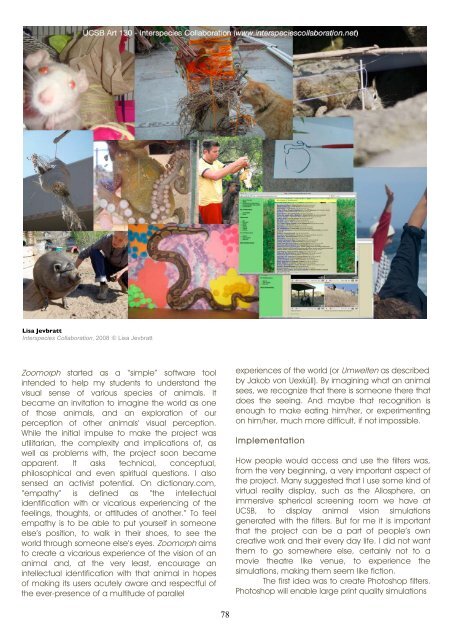Animal Influence I - Antennae The Journal of Nature in Visual Culture
Animal Influence I - Antennae The Journal of Nature in Visual Culture
Animal Influence I - Antennae The Journal of Nature in Visual Culture
Create successful ePaper yourself
Turn your PDF publications into a flip-book with our unique Google optimized e-Paper software.
Lisa Jevbratt<br />
Interspecies Collaboration, 2008 Lisa Jevbratt<br />
Zoomorph started as a “simple” s<strong>of</strong>tware tool<br />
<strong>in</strong>tended to help my students to understand the<br />
visual sense <strong>of</strong> various species <strong>of</strong> animals. It<br />
became an <strong>in</strong>vitation to imag<strong>in</strong>e the world as one<br />
<strong>of</strong> those animals, and an exploration <strong>of</strong> our<br />
perception <strong>of</strong> other animals’ visual perception.<br />
While the <strong>in</strong>itial impulse to make the project was<br />
utilitarian, the complexity and implications <strong>of</strong>, as<br />
well as problems with, the project soon became<br />
apparent. It asks technical, conceptual,<br />
philosophical and even spiritual questions. I also<br />
sensed an activist potential. On dictionary.com,<br />
“empathy” is def<strong>in</strong>ed as “the <strong>in</strong>tellectual<br />
identification with or vicarious experienc<strong>in</strong>g <strong>of</strong> the<br />
feel<strong>in</strong>gs, thoughts, or attitudes <strong>of</strong> another.” To feel<br />
empathy is to be able to put yourself <strong>in</strong> someone<br />
else’s position, to walk <strong>in</strong> their shoes, to see the<br />
world through someone else’s eyes. Zoomorph aims<br />
to create a vicarious experience <strong>of</strong> the vision <strong>of</strong> an<br />
animal and, at the very least, encourage an<br />
<strong>in</strong>tellectual identification with that animal <strong>in</strong> hopes<br />
<strong>of</strong> mak<strong>in</strong>g its users acutely aware and respectful <strong>of</strong><br />
the ever-presence <strong>of</strong> a multitude <strong>of</strong> parallel<br />
78<br />
experiences <strong>of</strong> the world (or Umwelten as described<br />
by Jakob von Uexküll). By imag<strong>in</strong><strong>in</strong>g what an animal<br />
sees, we recognize that there is someone there that<br />
does the see<strong>in</strong>g. And maybe that recognition is<br />
enough to make eat<strong>in</strong>g him/her, or experiment<strong>in</strong>g<br />
on him/her, much more difficult, if not impossible.<br />
Implementation<br />
How people would access and use the filters was,<br />
from the very beg<strong>in</strong>n<strong>in</strong>g, a very important aspect <strong>of</strong><br />
the project. Many suggested that I use some k<strong>in</strong>d <strong>of</strong><br />
virtual reality display, such as the Allosphere, an<br />
immersive spherical screen<strong>in</strong>g room we have at<br />
UCSB, to display animal vision simulations<br />
generated with the filters. But for me it is important<br />
that the project can be a part <strong>of</strong> people’s own<br />
creative work and their every day life. I did not want<br />
them to go somewhere else, certa<strong>in</strong>ly not to a<br />
movie theatre like venue, to experience the<br />
simulations, mak<strong>in</strong>g them seem like fiction.<br />
<strong>The</strong> first idea was to create Photoshop filters.<br />
Photoshop will enable large pr<strong>in</strong>t quality simulations












